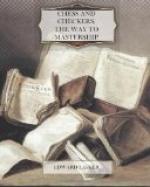There are possibilities of a player mating his opponent with only King and Knight or King and Bishop, but then there must be a man of the opponent blocking the escape of the King. Diagram 10 is an example of such a case. White plays (1) Kt-c5, K-h1; (2) Kt-e4. Now Black cannot continue with P-h2, as White would checkmate with Kt-g3. Therefore, he must play (2) ..., K-h2. White then gets the Knight in such a position as to deprive Black’s King of the escape to h2 and to keep the square g3 accessible to the Knight: (3) Kt-d2 (not Kt-g3, which would stalemate Black’s King), K-h1; (4) Kt-f1. The only move left to Black is now P-h2, and White mates by (5) Kt-g3.
If it were Black’s move in the position of the Diagram the game would be a draw, for after (1) ..., K-h1; (2) Kt-c5, P-h2 Black is stalemate unless White moves his King so as to make the square g1 accessible to Black. However, he will not do that as it would enable Black to queen the Pawn and to win the game.
In the case of King and Bishop against King and another man a mate can only occur through a blunder. Supposing for instance White has the King on f3 and a Bishop on d5 and Black has the King on h1 and a Bishop or a Pawn on h2, then White on the move would mate by K-f2. But it is evident that Black must have made a blunder, for on the move preceding the position of the Diagram he must have either played his King into the corner or moved the Bishop or Pawn to h2, both moves which were in no way forced.
To checkmate with King and two Bishops against King or with Bishop and Knight against King offers no difficulty.
+---------------------------------------+ 8 | #K | | | | | | | | |---------------------------------------| 7 | | | | | | | | | |---------------------------------------| 6 | | | | | | | | | |---------------------------------------| 5 | | | | | | | | | |---------------------------------------| 4 | | | | | | | | | |---------------------------------------| 3 | | | | | | | | | |---------------------------------------| 2 | | | | | | | | | |---------------------------------------| 1 | ^K | ^B | ^B | | | | | | +---------------------------------------+ a b c d e f g h
Diagram 11.
The only thing the player must keep in mind is that he needs his King for the drive. The two pieces are not sufficient to confine the opposing King to the corner. In Diagram 11 for instance, it will be the best policy for White to advance right away with his King in order to prevent Black’s King from escaping into the middle of the board. The following play might then ensue:
(1) K-b2, K-b7; (2) K-c3, K-c6; (3) K-d4, K-d6; (4) B-f5, K-c6; (5) B-f4, K-b5; (6) B-e4, K-b4; (7) B-d3, K-b3; (8) B-d2, K-b2; (9) K-c4, K-a3; (10) K-c3, K-a4; 11) K-c2 (not K-b2 which would stalemate Black’s King), K-a3; (12) B-b5, K-a2; (13) B-c1, K-a1; (14) B-b2, K-a2; (15) B-c4 mate.




